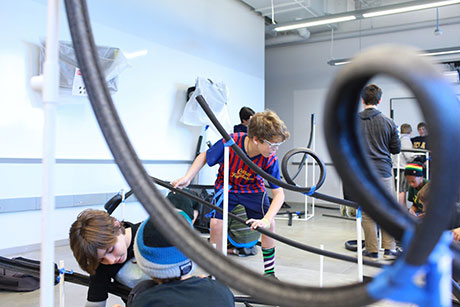Play-based learning: Teaching Physics Through Roller Coasters

Kids have marveled at and been thrilled by roller coasters since they were introduced in the 1800s. Anyone daring enough to take a ride on one of these beasts has been tossed and turned and twisted into absolute hysteria, elation, or some kind of sickness. But why? How? What are the secrets that guide inventors in the creation of such death-defying thrill rides?
These are the questions that brought roller coasters into our classroom as we guide our students to develop an understanding of the laws of physics: forces, motion, and energy. At GameDesk and the PlayMaker School, we are interested in challenging our students to make observations, explore, be thoughtful, and seek knowledge through investigation and inquiry.
In a more traditional model, creating a roller coaster might serve as a culminating activity at the END of a long module/lesson plan involving the study of energy and forces in motion. Students would have already been taught the necessary vocabulary and spent hours reading textbooks and absorbing lectures about the topic. Building the coasters would be a method for teacher assessment of student understanding.
Our approach is different. We want to create broad contexts through which students explore and discover ideas organically. Vocabulary isn’t front-loaded, but is introduced, instead, when a need arises for students to describe something they have discovered. For example, when studying waves, terms like amplitude, frequency, and wave length were not introduced until students needed a way to describe things they were extracting from hands-on experience. We endeavor to have students develop an intuitive understanding of concepts and then attempt to explain them in a constructivist mold.
First, we played the online game - JASON Digital Lab Coaster Creator. This free game is available on Educade.org, along with the lesson plan we use in our classroom. Students use a menu to build a 2-D rollercoaster with dips, rises, and loops. The kids try to create an exciting ride that stops in a precise location. They begin to notice that there is a relationship between height and speed/energy. The game also begins their exposure to the terms ‘kinetic energy’ (KE) and ‘potential energy’ (PE). The game generates a lot of fiero moments, where students throw their hands in the air in prideful celebration. After some playful digging using the coaster website, we moved on to further creative exploration with physical materials.
Student groups were then given PVC pipe, brackets and connectors, painter’s tape, insulation tubing that had been cut in half to allow for tracks to be shaped, and ball bearings that would act as the coasters themselves. With these materials, we set them free to build elaborate, physical roller coasters. The room was abuzz with ideas about supports for the coaster base, the number of loops that should be created,, and what limits there were to the physical capabilities of the coasters. Students were asked to verbalize where potential energy translated to kinetic energy in their physical coaster designs; this articulation served as an assessment of their learning outcomes form the digital roller coaster creator. They constructively argued their cases for a particular design or feat of engineering. Assumptions were made, attempts were observed, failures were analyzed, adjustments were implemented, and successes were met with boisterous cheers from group members. We also leveraged this making opportunity to teach how to calculate speed and integrated mathematics as a tool to expand their understanding.

Clearly, engagement and playfulness was at a premium. But what was gained? Students understood the basic idea that enough potential energy must be created in the system to sustain the coaster through loops and hills and twists and turns. Knowledge of dissipated energy, friction, and gravity was derived from genuine exploration. We would stipulate that students observed and intuited more about the applicable concepts of physics through playful inquiry than they would have from any lecture or chapter they may have been exposed to in class.
Tools and ideas to transform education. Sign up below.
As we reflect on this process, we think that even more could be woven into the activity. We could create an economy where groups would have to plan a budget and actually purchase different materials in the building of their final coasters. We could launch marketing campaigns where groups create coasters for a more authentic audience (other students) and invite them to play and provide feedback. We could introduce another mathematical strand where students worked with ideas about scale and size.
What might you create? What might your students create? We are unbelievably excited about this approach to education and look forward to more innovation.
Tedd Wakeman and AJ Webster teach at the PlayMaker School, which emphasizes learning through play, discovery and inquiry.
